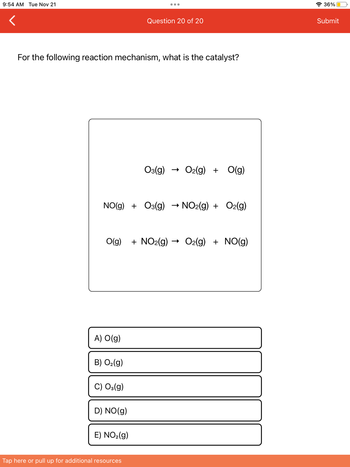
Chemistry
10th Edition
ISBN: 9781305957404
Author: Steven S. Zumdahl, Susan A. Zumdahl, Donald J. DeCoste
Publisher: Cengage Learning
expand_more
expand_more
format_list_bulleted
Question

Transcribed Image Text:9:54 AM Tue Nov 21
For the following reaction mechanism, what is the catalyst?
NO(g)+O3(g) → NO2(g) + O2(g)
A) O(g)
O(g) +NO2(g) O2(g) + NO(g)
B) O₂(g)
C) O3(g)
Question 20 of 20
D) NO(g)
E) NO₂(g)
O3(g) O2(g) + O(g)
Tap here or pull up for additional resources
36%
Submit
Expert Solution
This question has been solved!
Explore an expertly crafted, step-by-step solution for a thorough understanding of key concepts.
This is a popular solution
Trending nowThis is a popular solution!
Step by stepSolved in 3 steps

Knowledge Booster
Learn more about
Need a deep-dive on the concept behind this application? Look no further. Learn more about this topic, chemistry and related others by exploring similar questions and additional content below.Similar questions
- why the increasing concentration of only one reactant may not affect the reaction rate?arrow_forwardPress the hotspot that indicates the enthalpy of an exothermic reaction. Activated complex Activation energy Energy Reactants AH Prod o ts Reactionarrow_forwardIn studying a reaction that goes to completion (this is not a reversible reaction) what happens to the rate with the addition of a catalyst? Will the rate increase, decrease, or stay the same?arrow_forward
- A catalyst will... provide an alternate. pathway for a reaction that requires less activation energy be used up in the reaction provide an alternate. pathway for a reaction that requires more activation energyarrow_forwardWhat are three factors that affect ' rate of reactions'arrow_forward12. What would happened to the rate of the reaction by decreasing the number of moles of reacting molecules, decreasing the temperature, and removing a catalyst?arrow_forward
- The following figure represents chemical reaction before and after using a catalyst and from the figure it is obvious that 300 a-catalyst preserve heat energy its value is 100KJ/mol on the usage of the catalyst 100 Reactant b-this reaction is endothermic Product -100- c-activation energy of the forward reaction with out a catalyst is 200KJ/mol d-the catalyst increases energy of reactants which increases rate of the reaction Progress of reaction Energy,(k/mol)arrow_forwardThe catalyst influences the rate of reaction in which ways? nothing happens O Decreases it O Increases it O Stops the reactionarrow_forwardWhich of the following terms is described as the amount of energy reactants are required to absorb to product products? A)kinetic energy B)potential energy C)catalyst energy D)activation energyarrow_forward
- According to collision theory, the molecules must have enough energy when they collide to cause chemical bonds to break and form. In other words, for a reaction to happen. What do we call the minimum energy required to initiate a chemical reaction? Choose from the choices below: Activation energy Collision energy Heat energy Reaction energyarrow_forwardHow does a catalyst influence the rate of a reaction?arrow_forwardWhich reaction would happen faster: the oxidation of a steel plate or the oxidation of a ball of steel wool? Explain your answer using collision theory.arrow_forward
arrow_back_ios
SEE MORE QUESTIONS
arrow_forward_ios
Recommended textbooks for you
 ChemistryChemistryISBN:9781305957404Author:Steven S. Zumdahl, Susan A. Zumdahl, Donald J. DeCostePublisher:Cengage Learning
ChemistryChemistryISBN:9781305957404Author:Steven S. Zumdahl, Susan A. Zumdahl, Donald J. DeCostePublisher:Cengage Learning ChemistryChemistryISBN:9781259911156Author:Raymond Chang Dr., Jason Overby ProfessorPublisher:McGraw-Hill Education
ChemistryChemistryISBN:9781259911156Author:Raymond Chang Dr., Jason Overby ProfessorPublisher:McGraw-Hill Education Principles of Instrumental AnalysisChemistryISBN:9781305577213Author:Douglas A. Skoog, F. James Holler, Stanley R. CrouchPublisher:Cengage Learning
Principles of Instrumental AnalysisChemistryISBN:9781305577213Author:Douglas A. Skoog, F. James Holler, Stanley R. CrouchPublisher:Cengage Learning Organic ChemistryChemistryISBN:9780078021558Author:Janice Gorzynski Smith Dr.Publisher:McGraw-Hill Education
Organic ChemistryChemistryISBN:9780078021558Author:Janice Gorzynski Smith Dr.Publisher:McGraw-Hill Education Chemistry: Principles and ReactionsChemistryISBN:9781305079373Author:William L. Masterton, Cecile N. HurleyPublisher:Cengage Learning
Chemistry: Principles and ReactionsChemistryISBN:9781305079373Author:William L. Masterton, Cecile N. HurleyPublisher:Cengage Learning Elementary Principles of Chemical Processes, Bind...ChemistryISBN:9781118431221Author:Richard M. Felder, Ronald W. Rousseau, Lisa G. BullardPublisher:WILEY
Elementary Principles of Chemical Processes, Bind...ChemistryISBN:9781118431221Author:Richard M. Felder, Ronald W. Rousseau, Lisa G. BullardPublisher:WILEY

Chemistry
Chemistry
ISBN:9781305957404
Author:Steven S. Zumdahl, Susan A. Zumdahl, Donald J. DeCoste
Publisher:Cengage Learning

Chemistry
Chemistry
ISBN:9781259911156
Author:Raymond Chang Dr., Jason Overby Professor
Publisher:McGraw-Hill Education

Principles of Instrumental Analysis
Chemistry
ISBN:9781305577213
Author:Douglas A. Skoog, F. James Holler, Stanley R. Crouch
Publisher:Cengage Learning

Organic Chemistry
Chemistry
ISBN:9780078021558
Author:Janice Gorzynski Smith Dr.
Publisher:McGraw-Hill Education

Chemistry: Principles and Reactions
Chemistry
ISBN:9781305079373
Author:William L. Masterton, Cecile N. Hurley
Publisher:Cengage Learning

Elementary Principles of Chemical Processes, Bind...
Chemistry
ISBN:9781118431221
Author:Richard M. Felder, Ronald W. Rousseau, Lisa G. Bullard
Publisher:WILEY